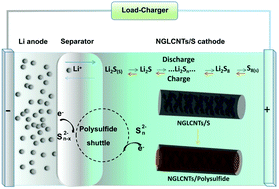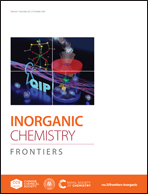N-Doped graphitic ladder-structured carbon nanotubes as a superior sulfur host for lithium–sulfur batteries†
Abstract
Lithium–sulfur (Li–S) batteries have been becoming a new generation of secondary batteries due to their high theoretical energy density. Regarding sulfur-based cathodes, they not only help to strengthen the utilization of sulfur, but also effectively immobilize polysulfides to alleviate their dissolution and diffusion. Herein, a new confinement strategy is initiated by a distinctive sulfur scaffold, namely nitrogen doped graphitic ladder-structured carbon nanotubes (NGLCNTs) loaded with appropriate amount of metallic cobalt nanoparticles. Benefiting from both the unique graphitic ladder-structure and metallic cobalt nanoparticles in the nitrogen doped carbon nanotubes, the NGLCNTs host not only promotes ion transfer and electron transmission during the redox reactions from higher-order polysulfides to Li2S2/Li2S, but also efficiently restricts the outward diffusion and dissolution of polysulfides as well as benefits the nucleation and growth of Li2S. As a result, the NGLCNTs/S cathode has successfully overcome the crucial issues, and it exhibits greatly enhanced electrochemical performances with excellent rate capabilities of up to 8C and long term cycling life of over 500 cycles.



 Please wait while we load your content...
Please wait while we load your content...